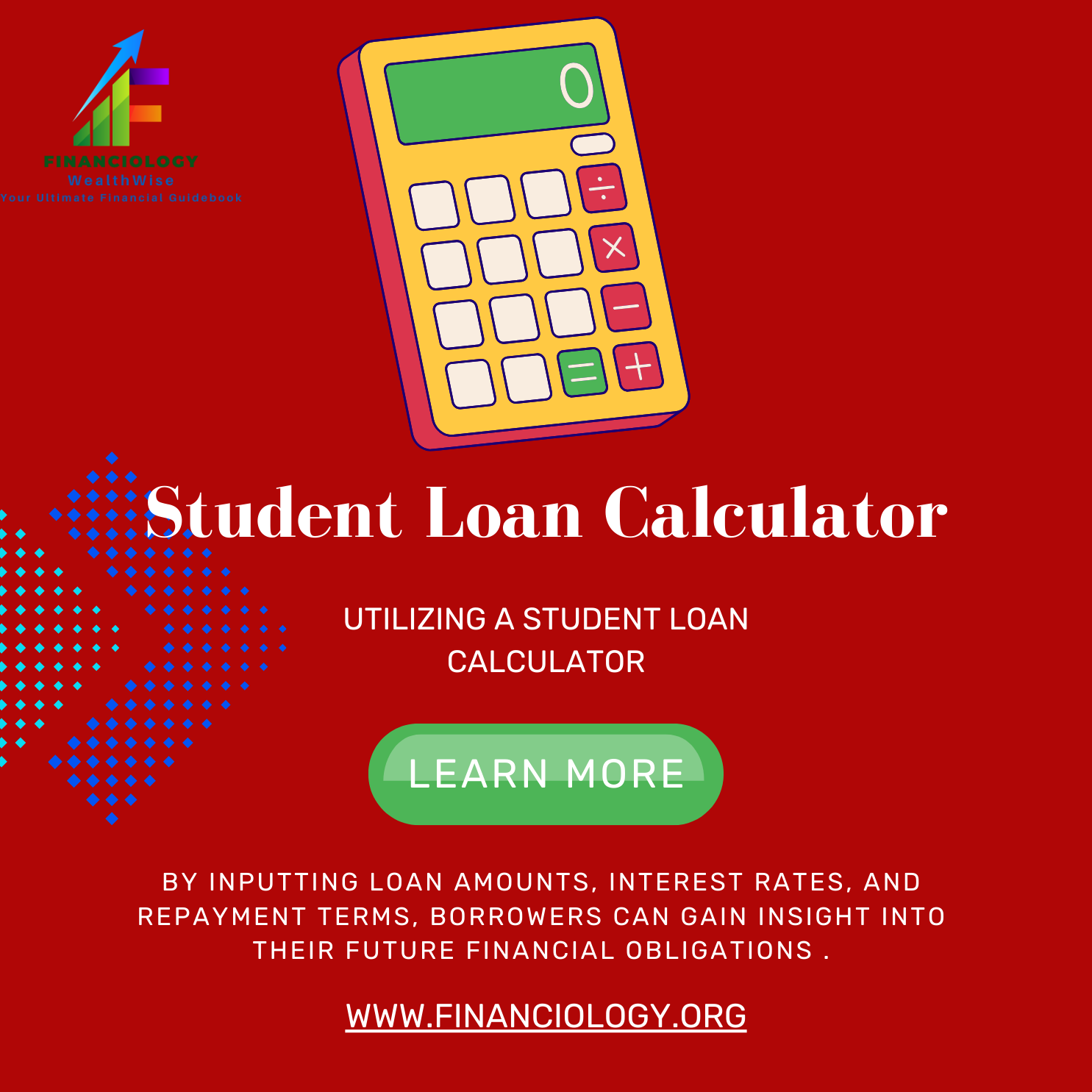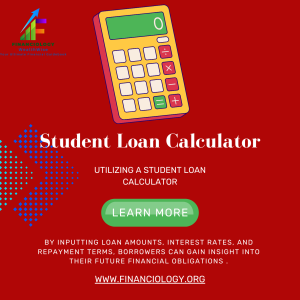Updated Student Loan Calculator 2024
9 min read
Student Loan Calculator
Student Loan Calculator 2024
This video does not exist. $500 $10 $1440 $1940 The repayment amount shown using this calculator is an estimate, based on the information you have provided. It is provided for illustrative purposes only and actual repayment amounts may vary. To find out actual repayment amounts, contact us. This calculation does not constitute a quote, loan approval, agreement, or advice by My Finance. It does not take into account your personal or financial circumstances.
WealthWise: Your Ultimate Financial Guidebook
Sorry
Period
Payment
Interest
Balance
Application fee
Monthly fee
Total regular fees
Total fees
Student Loan Calculator Disclaimer
Demystifying Student Loans: Understanding Federal, State, and Private Options
Navigate the world of student loans with clarity. Discover the differences between federal, state, and private student loans and how a student loan calculator can aid in financial planning.
Student loans are a common avenue for financing higher education, but navigating the various options can be overwhelming. Understanding the differences between federal, state, and private student loans is crucial for making informed decisions about financing your education.
In this blog, we’ll explore each type of student loan and how they differ, along with the importance of utilizing a student loan calculator for effective financial planning.
1. Federal Student Loan:
Federal student loans are loans offered by the government to help students and their families cover the cost of higher education. These loans typically have lower interest rates and more flexible repayment options compared to private loans. There are several types of federal student loans, including Direct Subsidized Loans, Direct Unsubsidized Loans, and Direct PLUS Loans.
Key Features of Federal Student Loans:
- Fixed interest rates set by Congress, are usually lower than private loan rates.
- Income-driven repayment plans, such as Income-Based Repayment (IBR) and Pay As You Earn (PAYE), which adjust monthly payments based on income and family size.
- Deferment and forbearance options are available during times of financial hardship.
- Potential eligibility for loan forgiveness programs, such as Public Service Loan Forgiveness (PSLF) for those working in qualifying public service positions.
2. State Student Loan:
State student loans are loans offered by individual states or state agencies to residents attending eligible colleges and universities within the state. These loans may offer competitive interest rates and additional benefits for state residents. However, eligibility requirements and loan terms vary depending on the state and specific loan program.
Key Features of State Student Loans:
- Interest rates and terms are determined by the state, which may vary based on residency and financial need.
- Some state loan programs offer borrower benefits, such as interest rate reductions for automatic payments or on-time payments.
- Eligibility criteria may include state residency, enrollment in an eligible institution, and satisfactory academic progress.
- State loan forgiveness or repayment assistance programs may be available for borrowers working in certain fields or serving specific populations within the state.
3. Private Student Loan:
Private student loans are offered by banks, credit unions, and other private lenders to cover educational expenses not met by federal or state aid. These loans often require a credit check and may have higher interest rates compared to federal loans. Private loans may be used to supplement other forms of financial aid but should be approached with caution due to potentially less favorable terms and fewer borrower protections.
Key Features of Private Student Loans:
- Variable or fixed interest rates are determined by the lender, based on the borrower’s creditworthiness and other factors.
- Repayment terms and options vary by lender, with fewer flexible repayment plans compared to federal loans.
- Cosigner options are available to help borrowers qualify for lower interest rates or higher loan amounts.
- Private loans may require payments while the borrower is still in school, unlike federal loans with deferment options.
Utilizing a Student Loan Calculator:

Whether considering federal, state, or private student loans, using a student loan calculator can be invaluable for estimating monthly payments, comparing loan options, and understanding the long-term financial implications of borrowing for education.
By inputting loan amounts, interest rates, and repayment terms, borrowers can gain insight into their future financial obligations and make informed decisions about borrowing for college.
In conclusion, understanding the differences between federal, state, and private student loans is essential for navigating the complex landscape of higher education financing. Each type of loan offers unique benefits and considerations, and careful consideration should be given to borrowing responsibly.
By leveraging resources such as student loan calculators and exploring all available financial aid options, students can make informed decisions that support their educational goals while minimizing financial burden in the long run.
Navigating Student Loan Repayment Options

A Comprehensive Guide: Discover the various repayment options available for student loans and learn how to manage your debt effectively. From federal programs to private lender offerings, explore strategies for repaying student loans that align with your financial goals.
When it comes to repaying student loans, understanding your options is key to managing debt effectively. From federal programs designed to ease the burden for borrowers to unique offerings from private lenders, there are various strategies available to help you navigate the repayment process.
In this guide, we’ll explore student loan repayment options in detail, empowering you to make informed decisions about managing your educational debt.
1. Federal Student Loan Repayment Options:
Federal student loans offer several repayment plans tailored to accommodate diverse financial circumstances. These options include:
- Standard Repayment Plan: Fixed monthly payments over a 10-year term.
- Graduated Repayment Plan: Payments start low and increase every two years over a 10-year term.
- Income-Driven Repayment Plans: Monthly payments based on income and family size, with options such as Income-Based Repayment (IBR), Pay As You Earn (PAYE), Revised Pay As You Earn (REPAYE), and Income-Contingent Repayment (ICR).
Key Features of Federal Student Loan Repayment:
- Flexibility to switch between repayment plans as financial circumstances change.
- Potential eligibility for loan forgiveness programs, such as Public Service Loan Forgiveness (PSLF) after meeting specific criteria.
- Extended and graduated repayment options available for borrowers who need lower monthly payments over a longer term.
2. Private Student Loan Repayment Options:
Private student loans typically offer fewer repayment options compared to federal loans. However, borrowers may still have some flexibility depending on the lender. Common repayment options include:
- Standard Repayment: Fixed monthly payments over a specified term, similar to federal loans.
- Interest-Only Repayment: Pay only the interest while in school or during a specified grace period, followed by full principal and interest payments.
- Deferred Repayment: No payments are required while in school, with repayment beginning after graduation or when the grace period ends.
Key Features of Private Student Loan Repayment:
Varied repayment terms and options depending on the lender.
- Some lenders offer forbearance or hardship options for borrowers experiencing financial difficulties.
- Consideration of refinancing or consolidation to potentially lower interest rates or adjust repayment terms.
3. Consolidation and Refinancing:
Consolidation involves combining multiple federal loans into a single loan with a fixed interest rate, simplifying repayment but potentially extending the term. Refinancing, on the other hand, applies to both federal and private loans and involves obtaining a new loan with a private lender to replace existing loans, often with a lower interest rate and different repayment terms.
Key Considerations for Consolidation and Refinancing:
- Impact on interest rates and repayment terms.
- Loss of federal loan benefits, such as income-driven repayment options and loan forgiveness programs, when refinancing federal loans with a private lender.
- Creditworthiness requirements and potential need for a cosigner when refinancing private loans.
Choosing the Right Repayment Option:
When selecting a repayment plan, consider factors such as income, career trajectory, and long-term financial goals. Evaluate each option’s pros and cons, including monthly payments, total interest paid, and eligibility for forgiveness or discharge programs.
Additionally, stay informed about changes in repayment options and regularly reassess your financial situation to ensure your chosen plan remains the best fit.
In conclusion, navigating student loan repayment options requires careful consideration and understanding of the available programs and strategies. By exploring federal and private loan repayment plans, as well as consolidation and refinancing options, borrowers can develop a customized approach to managing their educational debt that aligns with their financial objectives.
Remember to stay proactive, seek guidance when needed, and prioritize effective debt management to achieve financial stability post-graduation.
Recent Posts:
- Discover the top instant loan apps in 2024
- A Review of Allied Insurance Company in 2024
- Streamline Your Finances with HDFC Netbanking
- Explore the Benefits of Capital One Online Banking
- Discover Financial Insights of Wells Fargo Online Banking
Q: What are the major repayment plans for federal student loans?

A: When it comes to federal student loans, borrowers have access to several repayment plans tailored to accommodate diverse financial circumstances. Here are the major repayment plans for federal student loans:
- Standard Repayment Plan: This plan involves fixed monthly payments over a 10-year term. It’s a straightforward option for borrowers who can afford higher monthly payments and want to pay off their loans quickly.
- Graduated Repayment Plan: With this plan, payments start low and increase every two years over a 10-year term. It’s beneficial for borrowers who expect their income to rise steadily over time and can manage increasing payments.
- Income-Driven Repayment Plans: These plans calculate monthly payments based on income and family size, providing flexibility for borrowers facing financial challenges. Options include:
- Income-Based Repayment (IBR): Caps payments at a percentage of discretionary income, with forgiveness available after 20 or 25 years of qualifying payments.
- Pay As You Earn (PAYE): Limits payments to 10% of discretionary income, with forgiveness available after 20 years of qualifying payments.
- Revised Pay As You Earn (REPAYE): Similar to PAYE but open to more borrowers and with forgiveness available after 20 or 25 years of qualifying payments.
- Income-Contingent Repayment (ICR): Caps payments at a percentage of income, with forgiveness available after 25 years of qualifying payments.
Each repayment plan offers unique benefits and considerations, allowing borrowers to choose the option that best fits their financial situation. Borrowers need to explore these plans thoroughly, considering factors such as monthly payments, total interest paid, and eligibility for loan forgiveness programs.
Additionally, borrowers can switch between repayment plans as their financial circumstances change, providing flexibility throughout the repayment process.





